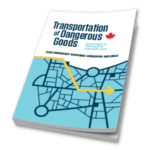 Bill C-33 Plans to Change Canada’s Transportation of Dangerous Goods Act
Bill C-33 Plans to Change Canada’s Transportation of Dangerous Goods Act
The regulatory system in Canada can be complicated – we don’t even have adorable cartoons like the American “I’m Just a Bill” to explain it all to us. But a knowledge of Acts versus Regulations is important for those who have to comply, and changes may be coming to the Transportation of Dangerous Goods Act (TDGA) that will have a significant effect on Canadian stakeholders.
Basically, an Act is a piece of legislation passed by Parliament. It’s the highest form of law and is usually not terribly specific. Acts usually set out the government’s intention to regulate a topic, assign what government body would be in charge (such as Transport Canada for transportation issues), and creates a framework for developing regulations. Regulations would be created by the designated body and would go into the details of what can and cannot be legally done.
Because Acts are created by Parliament, they’re difficult to change compared to Regulations. For example, the Transportation of Dangerous Goods Act still is dated “1992” for the last major overhaul. But the Canadian government is working on changes that, if they are passed, will change enforcement as well as allow Transport Canada to introduce its planned Client Identification Database (CID). These are found in Bill C-33, currently being studied by Parliament.
What Is Bill C-33?
First of all, it’s still a proposal up for debate by the House of Commons and the Senate, so what we’re discussing is not yet finalized. And it’s not just a proposal on the transportation of dangerous goods – it also will update parts of the Customs Act, the Railway Safety Act, the Canada Transportation Act, the Canada Marine Act, and Marine Transportation Safety Act. Obviously, this means that the transportation industry, and those who use it, should be prepared for eventual changes to a lot of aspects of the system.
The overall goal of this bill is to modernize the transportation system and especially the ports. As part of this, the enforcement system has been overhauled giving Transport Canada new ways of dealing with violations. In addition, some changes were made to the TDGA that would address issues Transport Canada was already working on, so there wouldn’t need to be another bill just for the TDGA.
What Would Bill C-33 Do if Passed?
Bill C-33 would make the following changes to the TDGA:
- Revise some existing requirements for testing means of containment (packaging) for compliance with regulatory requirements. The term “testing” will be replaced with “requalification.” This will clarify that “requalification” of means of containment doesn’t always involve testing.
- The Bill would re-enact the existing duty for the persons in charge of dangerous goods to report releases or anticipated releases and add that the full requirements of a report will be subject to further clarification in the “Transportation of Dangerous Goods Regulations.”
- In a major change, Bill C-33 would create a system of “Administrative Monetary Penalties” (AMP) as a new sort of penalty for violations that will occupy a space between the current methods of government-assigned fines and imprisonment. AMPs are different from standard fines in that they are voluntary arrangements between Transport Canada and the offender. The company or individual charged with a violation can avoid paying the standard fine for that violation if they agree to comply with conditions and terms given to them by Transport Canada. However, if they enter into an AMP and then don’t comply with the conditions they’re given, they could be subject to a penalty twice the amount of the penalty that would have been payable had the person not entered into the arrangement. On the other hand, unlike a regular fine, they could not be imprisoned for non-payment. Transport Canada believes this will help them encourage compliance without getting into “true penal consequences.”
- Finally, the Bill will amend the Act to authorize Transport Canada to set up a mandatory registration requirement for shippers and carriers, similar to that which currently exists in the United States under their “Hazardous Materials Regulations.” Creating this system, the Client Identification Database, required more changes than could be done simply by amending the “Transportation of Dangerous Goods Regulations.” Once the TDGA allows the creation of the CID, the regulations will be amended to add a new Part, Part 17, setting up the particulars about who must register and how.
Conclusions
While the changes to the TDGA sound technical, they can have some far-reaching implications for the future of how the “Transportation of Dangerous Goods Regulations” will function. But there’s lots of work to be done yet before this Bill becomes finalized. While it’s passed its “first reading” in the House of Commons, and was introduced for “second reading” in January 2023, it must clear many more steps, such as third reading in the Commons and the same three readings in the Senate. It will be interesting to see if this Bill can achieve its final destiny of becoming an Act.
Contact Us
Do you have any questions about upcoming regulatory changes in the United States or Canada? Our team of experts is just a call away for our customers at 855.734.5469 or send us an email, we’re happy to help.
Stay up to date and sign up for our newsletter!
We have all the products, services and training you need to ensure your staff is properly trained and informed.
 4GV UN Variation Boxes 4GV UN Variation Boxes |
 Canadian TDG Publications Canadian TDG Publications |
 Shipping Dangerous Goods Shipping Dangerous Goodsby Ground (TDGR) |
References:
LegisInfo, text of Bill C-33
Government of Canada, “Legislative Process”





